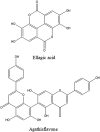Antinociceptive activity of the Caesalpinia eriostachys Benth. ethanolic extract, fractions, and isolated compounds in mice
- PMID: 35844922
- PMCID: PMC9281943
- DOI: 10.1002/fsn3.2846
Antinociceptive activity of the Caesalpinia eriostachys Benth. ethanolic extract, fractions, and isolated compounds in mice
Abstract
Caesalpinia eriostachys Benth. (CE) is native to the Mexico and multiple effects have been observed from several plants belonging to the same family. CE was subjected to extraction with 95% ethanol, and the components were isolated through column chromatography. The structure of the compound was elucidated based on nuclear magnetic resonance (NMR) spectral data, electron ionization-mass (EI-MS) spectroscopy, and liquid chromatography-mass (LC-MS) spectroscopy. In vivo antinociceptive studies were conducted using writhing, 5% formalin, tail-flick, hot-plate, and von Frey filament tests. The ethanolic extract showed a significant effect in the acetic acid-induced pain model and nociceptive behavior in the formalin model (second phase). In hot-plate test and tail-flick test, the results showed no difference compared to the control group. The results suggest that the ethanolic extract may act peripherally to reduce pain. In the streptozotocin (STZ)-induced pain model, the ethanolic extract showed significant effect in the von Frey test model. The n-Hex (Hexane) and MC (Methylene chloride) fractions and isolated compounds, ellagic acid and agathisflavone, showed increased effect. Based on these results, we confirmed that the CE ethanolic extract and their compounds, ellagic acid and agathisflavone, have antinociceptive effect on diabetes mellitus-induced pain. Furthermore, the results of this study might be valuable for identifying compounds with antinociceptive activity from natural products.
Keywords: Caesalpinia eriostachys Benth; agathisflavone; antinociceptive effect; pain; phytochemical analysis.
© 2022 The Authors. Food Science & Nutrition published by Wiley Periodicals LLC.
Conflict of interest statement
The authors declare that they have no conflict of interest.
Figures







References
-
- Ajileye, O. , Obuotor, E. , Akinkunmi, E. , & Aderogba, M. (2015). Isolation and characterization of antioxidant and antimicrobial compounds from Anacardium occidentale L. (Anacardiaceae) leaf extract. Journal of King Saud University‐Science, 27(3), 244–252. 10.1016/j.jksus.2014.12.004 - DOI
-
- Alves, C. Q. , David, J. M. , David, J. P. , Villareal, C. F. , Soares, M. B. , Queiroz, L. P. , & Aguiar, R. M. (2012). Flavonoids and other bioactive phenolics isolated from Cenostigma macrophyllum (Leguminosae). Química Nova, 35(6), 1137–1140. 10.1590/S0100-40422012000600013 - DOI
-
- Cavalcanti, M. , Fernandes, H. , Pereira, S. , Piauilino, C. , Costa, C. , Chaves, M. , Ibiapina, J. , Marques, R. , Oliveira, F. , & Almeida, F. (2017). Antinociceptive and Anti‐inflammatory Effects of the Hydroalcoholic Fraction from Leaves of Cenostigma macrophyllum Tul. var. acuminata Teles Freire (Leguminosae) in Rodents. Orthopedics and Rheumatology Open Access Journal, 8, 2. 10.19080/OROAJ.2017.08.555733 - DOI
LinkOut - more resources
Full Text Sources

